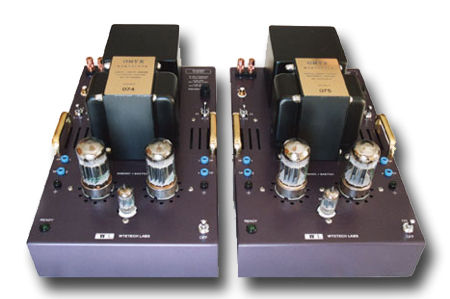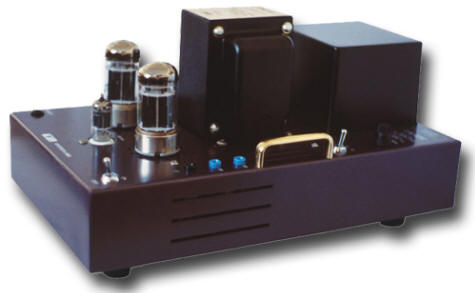You are reading the older HTML site
Positive Feedback
ISSUE
21
wyetech labs
Onyx amplifiers
as reviewed by Francisco Duran

|
FRANCISCO DURAN'S SYSTEM LOUDSPEAKERS ELECTRONICS SOURCE CABLES ACCESSORIES
|
I was recently speaking to a friend in the high-end audio business, and when I mentioned that I was listening to the Wyetech Onyx monoblock amplifiers, he commented that I was lucky to get a chance to hear them. His point was well taken. Wyetech components are not exactly distributed on the scale of Yamaha or Sony. Although a detailed description of the design and construction of the piece of equipment under consideration seems to be the pattern for most reviews, I will be brief. The build quality of the Onyx amplifiers, inside and out, is excellent. The lavender paint and gold trim is both beautiful and unique. I am sure that many people would like to see alternatives to the silver, black, or blinding chrome that so many manufacturers employ. The Onyx amplifiers have several design features that should appeal to tube amplifier lovers. Each output tube is self-biasing. Output impedances of 2, 4, 8, and 12 ohms can be selected via a sturdy switch located on top of the amplifier. There is a time-delayed power switch that is meant to provide proper sequencing for stabilizing the circuitry, and to extend tube life. The length of the signal path on the in-house-designed PC board is said to be less than six inches. You can argue until the next millennium about whether PCBs or hard wiring are more reliable or sound better, but I could not care less. I only care if a component sounds good and doesn't break down. I do like the self-biasing feature, though.
At first I was concerned that the Onyxs' 13 watts would have a hard time driving my Dali Euphonia MS-4s. but they had no problem. In fact, these amplifiers rocked, and rocked hard! While the Onyxs might be low in measurable output, they sound anything but small. For a time, I pressed my much more efficient Cain & Cain Abbey speakers into service with the Onyx amplifiers. They handled the Abbeys with ease, but the Euphonias were a better musical match.
The Onyxs' most notable traits were their superb micro- and macro-dynamics and their transient response. These amplifiers had a surprising grip and authority with every CD I played. From The Buena Vista Social Club's Orlando "Cachaito" Lopez to jazz bassist Steve Rodby, they reproduced acoustic bass with strength, fullness, resonance, and agility. Depending upon the recording, throw in spaciousness and depth. Slam and impact was not hindered with the Dalis. Classical pieces like Hovhaness' Mysterious Mountain (Telarc) sounded large and open, and did not break up at very loud levels. Bass sounded solid and controlled. More often than not, solid-state bass is tight and stiff, and does not sound natural. Bass through the Onyx monoblocks sounded full, weighty, and real, and it blended very smoothly with the rest of the frequency spectrum. I kept shaking my head at how 13 watts could handle—no, make that manhandle—89-dB speakers with eight drivers!
The humbucking guitar work on ZZ Top's latest, Mescalero, sounded grain-free and open from the upper midrange all the way to the top. The highs were clear and clean. Although there was a degree of smoothness and polished warmth, resolution and detail were not curtailed. On "Que Lastima," Billy Gibbons' guitar had gritty, yet liquid textures, and what sweet tone! If we're talking grungy guitars, let's not forget the Godfather Grunge, Neil Young. On Ragged Glory, he is backed by one of the best damned rock bands ever, Crazy Horse. I have played this CD so many times, it is a wonder I haven't worn a hole in it! Young's sweet, gritty tone was plentiful on this disc.

The Onyx amplifiers sounded brighter than that of any of the amplifiers I own, tube or solid state. Two other PFO writers who have heard the Onyx amplifiers, in their systems or a dealer's, told me that they felt the brightness was excessive. Although the phenomenon was easily noticeable, I did not find it excessive or distracting. I had many hours of good listening with the Onyx/Dali combination.
As is often the case at Casa Duran, amplifiers got switched around a lot during the course of this review. First up were my highly modified (by Response Audio) Antique Sound Labs AN-SPM25DT 25-watt monoblocks. The ASLs threw a slightly deeper and more squared-off soundstage. Their top end sounded more fleshed out and extended. The ASLs let you hear way into recordings. The Wyetech is equally dimensional and open, but a bit brighter and more forward. Music sounded effortless and open with both amplifiers. With the Onyx amplifiers, transients had a fascinating solidity. They fleshed out details with ease, in a soundstage that sounded a more "lit up" than with the ASLs. Percussion instruments on the CD Tribilistas sounded more clearly defined with the Onyx pair. They also reproduced more musical detail and nuance. Details were also fuller and more fleshed out than with the ASLs. A plucked string or drum tap had more dimension and weight with the Onyx amplifiers than with the Antique Sound Labs, even though the ASLs sounded a little darker.
Comparing the Onyxs to my Margules U280 SC was interesting. At first the Canadian amplifiers seemed to walk all over my lovely amplifier from south of the border, but my perspective changed on closer inspection. The most obvious difference was the way in which the two amplifiers handled the soundstage. While spacious, the Margules sounded a little closed-in on the sides and top of the stage. The Onyx monos sounded more exciting, open, and pedal-to-the-metal dynamic. The Margules amplifier offered slightly rounder transients, more polish, and a bit more restraint. The midrange sounded warmer, the top end very clean and polished. Bass was solid, but had less impact. Transients were slightly less sharp, making the midrange a tad more palatable, but with the Onyx pair, guitars were edgier, brighter, and (again) more open.
But wait a minute, the Margules was in triode mode. I switched it to ultralinear mode, which is going from 30 watts to 60, and the character of the amplifier changed. Suddenly it was less sweet and warm, and sounded more dynamic, neutral, and open. Switching from KT88 to KT90 output tubes gave even more bass and dynamics, and slightly less lushness. The amplifier now sounded clean, fast, grainless, and slick. Nevertheless, the Onyx amplifiers still held their own. They had a wider, more dimensional soundstage and faster, more solid bass transients.
Late in the review period, I bought a PS Audio power cord for my DVD player, to replace the cheap cord that came with it. Sure enough, the improvement in CD playback was very worthwhile. The effect this cord had on the sound of the Onyx amplifiers was interesting. The brightness was slightly curtailed, replaced by more harmonic information, not to mention an opening up of the soundstage. The point here is that careful system matching should be a priority with these amplifiers, as it should be with all components. You want them to sound their best? Set them up with thought and patience. The Onyx monoblocks are capable of high resolution and impressive dynamics. They sound like solid-state amplifiers with tube virtues. They are fast and detailed, yet they display dimensionality and beautiful harmonics. If you get to chance to listen to them, you might feel as lucky as I did. Francisco Duran
-
Power Output: 13 Watts RMS per channel
-
Frequency Response: 9Hz to 22kHz +0/-1 dB
-
Input Impedance: 60 kOhms
-
Gain: 29 dB
-
Dynamic Headroom: 2 dB (Music Peaks up to 40 watts)
-
Power Supply Storage: 280 Joules
-
Universal Voltage Select: 115/230 Volts 50/60Hz
-
Power Consumption 125 watts each
-
Dimensions: 8.5" H X 9.5" W x 16" D
-
Weight: 31lbs/ea
Onyx amplifiers
Retail: $4500 a pair
Wyetech Labs
web address:
www.wyetechlabs.com
